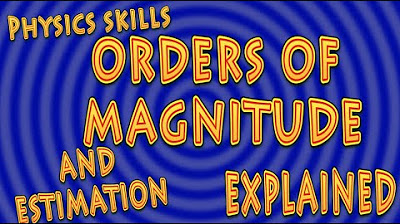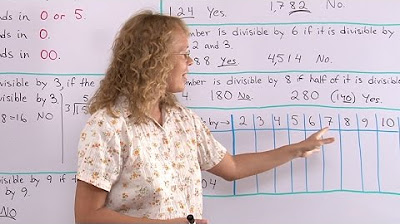Orders of Magnitude
TLDRThe video delves into the concept of an 'order of magnitude,' defined as rounding a number to the nearest power of 10 for simplification and comparison purposes. It illustrates this with examples, explaining how numbers like 300 (3 x 10^2) are approximated to 10^2, based on whether the leading digit is less or greater than 5. For instance, 7.3 x 10^4 is rounded to 10^5 because 7.3 is greater than 5. The video further clarifies this concept by converting numbers into scientific notation, then determining their order of magnitude for comparison, ultimately teaching how to calculate the difference in orders of magnitude between two numbers, providing a clear, step-by-step explanation of a fundamental scientific principle.
Takeaways
- 📈 The concept of 'order of magnitude' refers to numbers rounded to the nearest power of 10.
- 🔢 When rounding, if the first digit after the decimal is less than 5, it is rounded down to the nearest power of 10.
- 🔢 If the first digit after the decimal is 5 or greater, it is rounded up, and 1 is added to the power of 10.
- 🔍 To find the order of magnitude, convert a number to scientific notation if necessary.
- 🌟 Scientific notation expresses numbers as a product of a number between 1 and 10 and a power of 10.
- 🤔 For example, 300 is approximately 10^2, and 7.3 multiplied by 10^4 would be rounded to 10^5 due to the 7.3 being greater than 5.
- 🔢 The order of magnitude for 2432 is 10^3 because 2.432 is less than 5.
- 🔢 Conversely, the order of magnitude for 89,989,371 is 10^8 because 8.9 is greater than 5, thus rounded up.
- 📊 To compare orders of magnitude between two numbers, convert both to scientific notation first.
- 📈 The difference in orders of magnitude between two numbers can be found by subtracting their powers of 10.
- 📝 For instance, the number 3.45632e+05 differs by an order of magnitude of 10^4 from the number 5.6712342e+08.
Q & A
What is the definition of 'order of magnitude'?
-The order of magnitude refers to the process of rounding a number to its nearest power of 10. It provides an approximate value that indicates the scale or size of the original number.
How is the order of magnitude different from scientific notation?
-While both order of magnitude and scientific notation involve expressing numbers in relation to powers of 10, scientific notation is a more precise method that includes a coefficient between 1 and 10 and an exponent. Order of magnitude, on the other hand, focuses on the nearest power of 10 without specifying the coefficient.
How do you determine the order of magnitude for a number like 300?
-The order of magnitude for the number 300 is 10 to the power of 2 (10^2). This is because 300 is between 100 (10^2) and 1000 (10^3), making it closest to 100.
What rule is used to find the order of magnitude for numbers greater than 5?
-For numbers greater than 5, you round up to the next power of 10 by adding 1 to the exponent. For example, 7.3 would round to 10 to the power of 5 (10^5) because 7.3 is greater than 5.
How do you calculate the order of magnitude for a number like 2432?
-First, express 2432 in scientific notation, which is 2.432 × 10^3. Since the coefficient 2.432 is less than 5, the order of magnitude remains as 10^3.
What is the order of magnitude for the number 89,989,371?
-The number 89,989,371 in scientific notation is 8.989371 × 10^7. Since the coefficient 8.989 is greater than 5, the order of magnitude is rounded up to 10^8.
How do you compare two numbers by their orders of magnitude?
-To compare two numbers by their orders of magnitude, convert each number to its scientific notation and then compare the exponents. The difference in the exponents indicates the difference in orders of magnitude between the two numbers.
What is the difference in orders of magnitude between 345,632 and 567,123,000?
-345,632 has an order of magnitude of 10^5, and 567,123,000 has an order of magnitude of 10^8. The difference in their orders of magnitude is 10^8 - 10^5, which equals 10^8 - 10^5 = 10^4 (10 to the power of 4).
Why is the order of magnitude a useful concept?
-The order of magnitude is a useful concept because it simplifies very large or very small numbers, making it easier to compare and understand their scale relative to one another without getting bogged down in precise values.
How does rounding to the nearest power of 10 help in calculations?
-Rounding to the nearest power of 10 simplifies calculations by eliminating the need to deal with complex decimal places. It allows for quicker estimation and comparison of numbers, which can be particularly useful in various fields such as finance, science, and data analysis.
Can the order of magnitude be used to quickly estimate the size of a value in everyday situations?
-Yes, the concept of order of magnitude can be used in everyday situations to quickly estimate the size or scale of a value. For example, if you're comparing the populations of cities or the sizes of budgets, using orders of magnitude can provide a quick sense of their relative sizes without needing the exact figures.
What are some practical applications of understanding order of magnitude?
-Understanding order of magnitude is beneficial in various fields such as data analysis, scientific research, engineering, and finance. It helps in simplifying complex data, making quick estimations, and comparing large or small values more efficiently.
Outlines
📏 Understanding the Concept of Order of Magnitude
This paragraph introduces the concept of order of magnitude, which is a method of rounding numbers to the nearest power of 10. It explains that an order of magnitude is a way of expressing large or small numbers in a more simplified form by focusing on the power of 10 that the number is closest to. The explanation includes examples of how to determine the order of magnitude for different numbers, such as 300 (which is approximately 10^2) and 7.3 x 10^4 (which is closer to 10^5 because the decimal part, 7.3, is greater than 5). The paragraph also explains the process of converting numbers to scientific notation and using that format to find the order of magnitude, as demonstrated with the numbers 2432 (which is 2.432 x 10^3) and 89,989,371 (which is approximately 8.99 x 10^7). The main takeaway is that the order of magnitude helps in comparing the scale of different numbers by focusing on their relative magnitudes rather than their exact values.
🔢 Calculating the Difference in Orders of Magnitude
This paragraph delves into the process of calculating the difference in orders of magnitude between two large numbers. It begins by converting the given numbers, 345,632 and 567 million, into scientific notation, resulting in 3.45632 x 10^5 and 5.67123423 x 10^8, respectively. The explanation highlights the importance of moving the decimal point to achieve the scientific notation and how to determine the order of magnitude for each number based on the value of the decimal part. The paragraph then uses these orders of magnitude to calculate the difference between the two numbers, which is found to be 10^4, or four orders of magnitude. The key point is understanding how to work with orders of magnitude to compare and calculate differences between large numbers effectively.
Mindmap
Keywords
💡Order of Magnitude
💡Scientific Notation
💡Rounding
💡Power of 10
💡Decimal Point
💡Approximation
💡Comparing Magnitudes
💡Significant Figures
💡Conversion
💡Magnitude Scale
Highlights
The concept of 'order of magnitude' is introduced as a number rounded to the nearest power of 10.
An example is given to illustrate how the number 300 is approximately equal to 10 to the power of 2, emphasizing the use of a squiggly equals sign to denote approximation.
For numbers greater than 5, the power of 10 in the order of magnitude is increased by 1. This rule is demonstrated using the number 7.3 by 10 to the power of 4.
Numbers less than 5 keep their power of 10 the same in the order of magnitude, as shown with the number 2432.
The process of converting a number to scientific notation is briefly mentioned as a prerequisite for determining the order of magnitude.
An example calculation shows how the number 89,989,371 is converted to 8.9 three seven one by ten to the power of four in scientific notation.
The order of magnitude for the number 8.9 is 10 to the power of 5, as it is greater than 5.
A question is posed about comparing the order of magnitude between two large numbers, 345,632 and 567 million, by converting them to scientific notation.
The number 345,632 is converted to 3.45632 by 10 to the power of 5 in scientific notation.
The number 567 million is converted to 5.67123423 by 10 to the power of 8 in scientific notation.
The order of magnitude for 3.45632 is 10 to the power of 5, as it is less than 5.
The order of magnitude for 5.67123423 is 10 to the power of 9, as it is greater than 5.
The difference in order of magnitude between the two numbers is calculated to be 10 to the power of 4.
The method for determining the order of magnitude is emphasized as rounding to the nearest power of 10, which simplifies the comparison of large numbers.
The transcript provides a clear and methodical explanation of the order of magnitude concept and its application to scientific notation.
Transcripts
Browse More Related Video

Order of Magnitude

orders of magnitude explained

Divisibility rules for 3, 4, 6, 8 and 9

Converting between Moles, Atoms, and Molecules (Part 2)

Analyzing functions for discontinuities (continuous example) | AP Calculus AB | Khan Academy

Estimating limits from tables | Limits and continuity | AP Calculus AB | Khan Academy
5.0 / 5 (0 votes)
Thanks for rating: